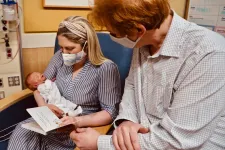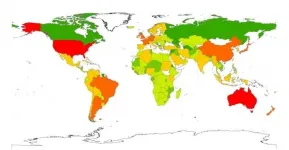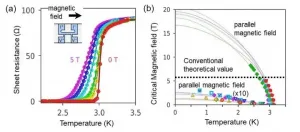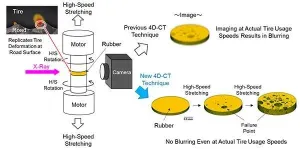(Press-News.org) Researchers at Cincinnati Children's Hospital Medical Center have developed a new framework for different factors influencing how a child's brain is "wired" to learn to read before kindergarten.
This may help pediatric providers identify risks when the brain is most responsive to experiences and interventions. This "eco-bio-developmental" model of emergent literacy, described in the journal JAMA Pediatrics, reinforces the potential of early screening, prevention, and intervention during pediatric clinic visits in early childhood.
This kind of model is advocated by the American Academy of Pediatrics to help better understand and improve important social determinants of health.
"Emergent literacy is a developmental process beginning in infancy, when the brain is rapidly developing. It involves skills, knowledge, and attitudes that are precursors to reading and writing," said John Hutton, MD, director of the Reading & Literacy Discovery Center at Cincinnati Children's. "Reading difficulties stem from deficits in any of these domains and take root early with far too many children beginning kindergarten unprepared to learn to read and at-risk of falling farther behind. Our research shows this is especially true for children from minority and impoverished backgrounds."
The model is separated into three categories: 1) ecological, 2) biological and 3) developmental. Ecological includes experiences in a child's home environment, such as reading, talking, teaching, and creative play. Biological includes genetics such as family history of dyslexia and medical conditions such as prematurity. Developmental includes cognitive, social-emotional, and brain health and abilities.
"Importantly, our model anchors these factors to neurobiology, which reflects how a functional 'reading network' develops in a child's brain," Hutton said. "Through neuroimaging, especially MRI, our research has found that more stimulating reading activities in the home environment prior to kindergarten are related to better developed brain structure and also function supporting literacy."
Cincinnati Children's has several programs in place for parents help their child, both in and out of the hospital. A new program is called "NICU Bookworms," through which families receive free books and encouragement to read to their baby during their stay in intensive care, which can be days or months long. They also receive empowering guidance on the benefits of "shared" book reading by trained NICU teams. This is an important resource, as families are often anxious about what they can do to help their child.
The program was part of a 2018-2019 study by neonatologists from Cincinnati Children's caring for babies in the NICU at the medical center and other local hospitals. The results, published recently in the Journal of Pediatrics, showed high-risk parents were five times more likely to read to their baby at home due to the intervention that took place at the hospital and that reading reduced the anxiety they felt during their child's stay.
A new book titled Baby Bookworm, written by Dr. Hutton and neonatologist Dr. Viral Jain, MD, to reinforce the NICU Bookworms program, was recently published. It gives parents in the NICU at Cincinnati Children's and other hospitals a way to help them bond with their babies.
Other early reading programs featured in the eco-bio-developmental model include: Reach Out and Read, through which children receive a new book and guidance about reading at home during well-visits from newborn through age 5; and Dolly Parton's Imagination Library, which mails new books to the child's home once a month from birth through age 5. Each of these are well-established at Cincinnati Children's, in Ohio and nationally.
Hutton also recently developed a new screening tool featured in the model called The Reading House, described in a recent study published in Pediatrics, which directly engages preschool-age children during clinic visits so pediatricians can assess their early literacy skills. The book has the potential to identify reading difficulties as early as age 3, target interventions to skills, and empower families to help their child at home.
"Rather than a passive approach, early literacy screening and interventions that are administered by pediatric practitioners through this new model can help identify potential reading difficulties, address risk factors during a period when neural plasticity is high, and improve outcomes," Hutton said.
INFORMATION:
The Reading House and Baby Bookworm are published by blue manatee press and available for hospitals, clinics and other nonprofits.
The study was funded by the Reading and Literacy Discovery center at Cincinnati Children's.
Potential conflicts of interest: Dr Hutton reported writing and publishing The Reading House
screening measure, which is not intended for sale in retail, library, or direct-to-consumer channels, and any royalties received are determined via intellectual property policies at the Cincinnati Children's Research Foundation; serving on the medical advisory board of Reach Out and Read with no financial compensation; and serving as a spokesperson for the Read Aloud 15 Minutes national campaign with no financial compensation during the conduct of the study. Drs. John Hutton and Viral Jain conceived and wrote the children's Baby Bookworm book featured in the NICU study. Books are provided free of charge.
Remote monitoring using airborne devices such as drones or satellites could revolutionise the effectiveness of nature-based solutions (NBS) that protect communities from devastating natural hazards such as floods, storms and landslides, say climate change experts from the University of Surrey.
Grey structural measures (a collective term for engineering projects that use concrete and steel) like floodgates, dams, dikes and sea walls are still the most common methods to guard against natural hazards. However, these 'grey measures' are expensive and lack the long-term flexibility and sustainability needed to help communities manage their growing population and address the planet's ongoing struggle against urbanisation ...
Scientists have discovered that tracking malaria as it develops in humans is a powerful way to detect how the malaria parasite causes a range of infection outcomes in its host.
The study, found some remarkable differences in the way individuals respond to malaria and raises fresh questions in the quest to understand and defeat the deadly disease.
Malaria, caused by the parasite - Plasmodium falciparum - is a huge threat to adults and children in the developing world. Each year, around half a million people die from the disease and another 250 million are infected. Malaria parasites are spread to humans through the bites of infected mosquitoes.
The outcomes that follow a malaria infection can vary from no symptoms to life-threatening ...
A team of scientists has been using DESY's X-ray source PETRA III to analyse the structural changes that take place in an egg when you cook it. The work reveals how the proteins in the white of a chicken egg unfold and cross-link with each other to form a solid structure when heated. Their innovative method can be of interest to the food industry as well as to the broad field of research surrounding protein analysis. The cooperation of two groups, headed by Frank Schreiber from the University of Tübingen and Christian Gutt from the University of Siegen, with scientists at DESY and European XFEL reports the research in two articles in the journal Physical Review Letters.
Eggs are among the most versatile food ingredients. They can take the form of a gel or ...
Adding the nutrient selenium to diets protects against obesity and provides metabolic benefits to mice, according to a study published today in eLife.
The results could lead to interventions that reproduce many of the anti-aging effects associated with dietary restriction while also allowing people to eat as normal.
Several types of diet have been shown to increase healthspan - that is, the period of healthy lifespan. One of the proven methods of increasing healthspan in many organisms, including non-human mammals, is to restrict dietary intake of an amino acid ...
Humans are creating or exacerbating the environmental conditions that could lead to further pandemics, new University of Sydney research finds.
Modelling from the Sydney School of Veterinary Science suggests pressure on ecosystems, climate change and economic development are key factors associated with the diversification of pathogens (disease-causing agents, like viruses and bacteria). This has potential to lead to disease outbreaks.
The research, by Dr Balbir B Singh, Professor Michael Ward, and Associate Professor Navneet Dhand, is published in the international journal, Transboundary and Emerging Diseases.
They found a greater diversity ...
Superconductivity is known to be easily destroyed by strong magnetic fields. NIMS, Osaka University and Hokkaido University have jointly discovered that a superconductor with atomic-scale thickness can retain its superconductivity even when a strong magnetic field is applied to it. The team has also identified a new mechanism behind this phenomenon. These results may facilitate the development of superconducting materials resistant to magnetic fields and topological superconductors composed of superconducting and magnetic materials.
Superconductivity has been used in various technologies, such as magnetic resonance imaging (MRI) and ...
Sumitomo Rubber Industries, Ltd (SRI) and Tohoku University teamed up to increase the speed of 4-Dimensional Computed Tomography (4D-CT) a thousand-fold, making it possible to observe rubber failure in tires in real-time.
This breakthrough will accelerate the development of new tire materials to provide super wear resistance, greater environmental friendliness, and longer service life. It will also aid significantly in the advancement of smart tires.
SRI initially developed 4D-CT as part of the ADVANCED 4D NANO DESIGN, a new materials development technology unveiled in 2015 that enables highly accurate analysis and simulation of the rubber's internal structure from the micro to nanoscale. This analysis ultimately ...
An evolutionary mystery that had eluded molecular biologists for decades may never have been solved if it weren't for the COVID-19 pandemic.
"Being stuck at home was a blessing in disguise, as there were no experiments that could be done. We just had our computers and lots of time," says Professor Paul Curmi, a structural biologist and molecular biophysicist with UNSW Sydney.
Prof. Curmi is referring to research published this month in Nature Communications that details the painstaking unravelling and reconstruction of a key protein in a single-celled, photosynthetic organism called a cryptophyte, a type of algae that evolved over a billion years ago.
Up until now, how cryptophytes acquired the proteins ...
About 61% of Americans have had at least one Adverse Childhood Experience (ACE), experts' formal term for a traumatic childhood event.
ACEs--which may include abuse, neglect and severe household dysfunction--often lead to psychological and social struggles that reach into adulthood, making ACEs a major public health challenge. But the long-term consequences of ACEs are just beginning to be understood in detail. To fill in the picture, two recent BYU studies analyzed how ACEs shape adolescents' delinquent behaviors as well as fathers' parenting approaches.
ACEs ...
An international survey that included 600 smokers in the UK has found that cessation messaging focused on easing the burden on our health system is most effective in encouraging people to quit.
The research, which was conducted in April-May 2020, randomly assigned participants to view one of four quit smoking messages, two of which explicitly referenced health implications and COVID-19, one referred more vaguely to risk of chest infection, and one highlighted financial motivations for quitting.
"We wanted to explore the effectiveness of smoking cessation messaging at a time when health systems the world over are beleaguered, and all our ...






